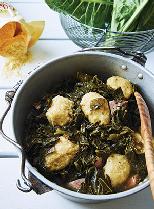
Title: Cabbage Collards and Potlikker with Cornmeal Dumplings
Yield: 6 servings.
Category: Vegetable
Cuisine: Southern
Source: Our State North Carolina magazine
Original Page from s:Ingredients
- [Collards
- 1 pound smoked pork pieces (such as ham hocks, ham bones, or side meat) OR smoked turkey pieces (such as wings)
- 12 cups cold water
- 2 pounds cabbage collards (regular collards can be substituted)
- 1 tablespoon cider vinegar
- 2 teaspoons salt, or to taste
- 1/2 teaspoon ground black pepper, or to taste
- 1-2 fresh jalapeño chilies or other hot chili (optional)
- 2 tablespoons brown sugar, sorghum, or cane syrup (optional)
- Cider vinegar, pepper vinegar, or hot sauce]
- [Cornmeal Dumplings
- 1 cup cornmeal
- 1 tablespoon all-purpose flour
- 1/2 teaspoon salt
- 1/4 teaspoon ground black pepper
- 1 cups potlikker, warmed
- 1 large egg, lightly beaten, but will lighten the dumplings) (optional)
- 1/4 cup very finely chopped onion] (optional)
Instructions
For the collards: Combine the pork and water in a large pot. Bring to a boil, reduce the heat, partially cover the pot, and simmer until the liquid reduces to 8 cups and develops a strong smoked pork flavor, about 3 hours. Strain the stock. (Pick any meat from the bones, shred it into small pieces, and return to the stock, if you wish.) Return the stock to the pot.
Remove and discard the stems and tough part of the inner ribs of the leaves by cutting them out with a knife, or by stripping the leaves off the stems by hand. Working in batches, cut the collard leaves into large, bite-size pieces. To remove the inevitable hidden grit, swish the collards in a sink or large bowl of cool water; let sit in the water for a few minutes so that the grit can fall to the bottom of the sink. Lift the greens out of the water and let them drain, but you don’t need to dry them.
Bring the stock to a low boil. Add the collards in large handfuls, stirring them into the hot stock and letting them wilt a bit before adding more.
Stir in the vinegar, salt, and pepper. Add the hot pepper and sugar, if using. Reduce the heat, and simmer gently until the greens are as tender and velvety as you like, 30 minutes to 1 hour. Taste the potlikker and adjust the seasoning as needed. Keep warm over low heat.
For the dumplings: Mix the cornmeal, flour, salt, and pepper in a bowl. Slowly stir in enough potlikker to make a smooth batter that is stiff enough to hold its shape on the spoon. Vigorously stir in the egg, if using. Fold in the onions, if using. Let the batter rest for 5 minutes.
Using hands dampened in cold water, form the batter into dumplings about the size of golf balls. Return the collards to a low boil. Arrange the dumplings on the surface, spacing them evenly. Cover the pot and cook until the dumplings are firm and cooked through, about 12 minutes.
Serve hot with cider vinegar, pepper vinegar, or hot sauce.
Notes
Most North Carolinians know their way around a pot of collards, but mild, tender, leafy, pale cabbage collards are an heirloom specialty Down East, and not well known statewide. Cabbage collards grow in loose heads, and are lighter in color and flavor than most collards. Unlike standard collards that taste best after a late frost or freeze, cabbage collards peak in late summer and early fall. Because of their delicate constitution, cabbage collards are usually seasoned with a lighter hand, but people are particular about their collards, so trust your palate to get them and the potlikker right.
Make-ahead note: Greens and potlikker are almost always better when made at least one day ahead and seem to improve with age, up to about three days.